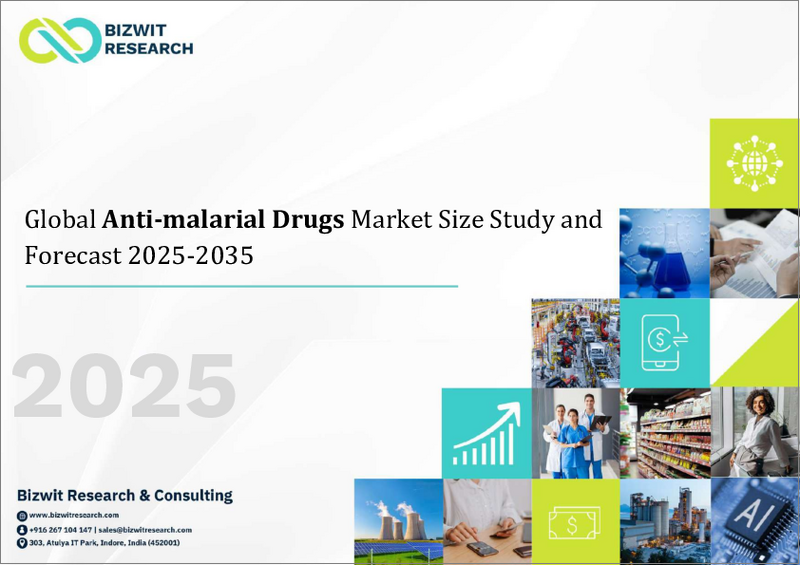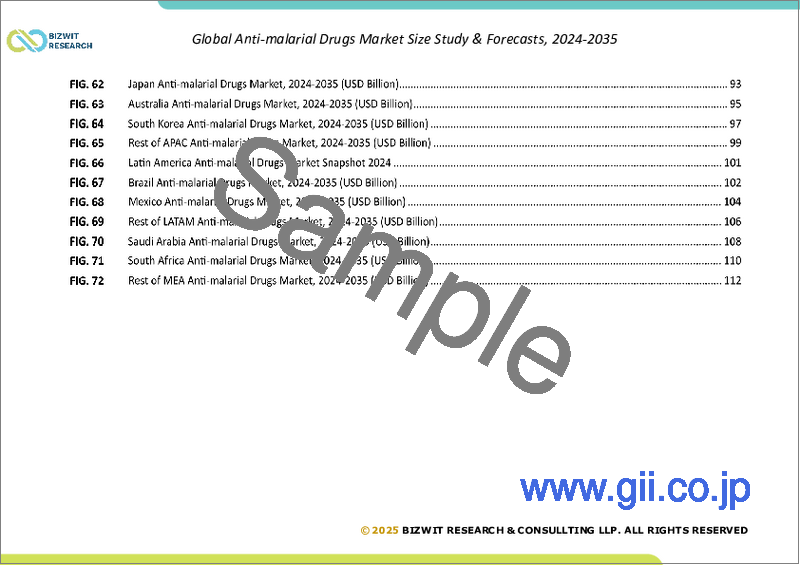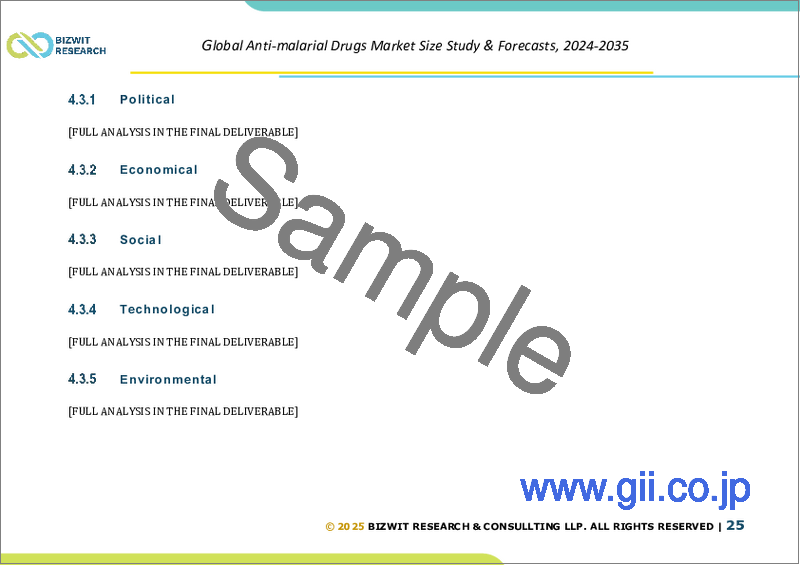|
|
市場調査レポート
商品コード
1735778
抗マラリア薬の世界市場規模調査:薬剤クラス別、マラリア種別、作用機序別、地域別予測:2022~2032年Global Anti-malarial Drugs Market Size study, by Drug Class, Malaria Type, and Mechanism of Action and Regional Forecasts 2022-2032 |
||||||
カスタマイズ可能
|
|||||||
| 抗マラリア薬の世界市場規模調査:薬剤クラス別、マラリア種別、作用機序別、地域別予測:2022~2032年 |
|
出版日: 2025年05月25日
発行: Bizwit Research & Consulting LLP
ページ情報: 英文 285 Pages
納期: 2~3営業日
|
全表示
- 概要
- 目次
抗マラリア薬の世界市場規模は2023年に約 9億8,000万米ドルとなり、予測期間2024~2032年のCAGRは4.26%以上と緩やかながら有望な成長が見込まれています。
マラリアとの永続的な闘いにおいて、抗マラリア薬は世界中の流行地域の何百万人もの人々にとって重要なライフラインとなっています。これらの治療薬は、感染後に寄生虫を駆除するか、人体内での寄生虫の発生を完全に防ぐように設計されています。気候の影響を受けやすい蚊が媒介する感染症の拡大、国境を越えた人口移動、不十分な衛生インフラなどが相まって、先進的で利用しやすく、耐久性のある抗マラリア治療プロトコルの緊急性が高まっています。
近年、Medicines for Malaria Venture(MMV)やWHO主導のマラリア撲滅ロードマップのような国際的な資金連合や官民パートナーシップによって、技術革新のパイプラインが復活しています。薬剤開発は、マラリア原虫と新興薬剤耐性株との闘いを目的とした、新規アルテミシニン系混合療法(ACT)と次世代抗溶解剤に傾注しています。製薬会社はまた、脆弱な人々のコンプライアンス問題を抑制できる単回投与や長時間作用型の薬剤の研究も進めています。しかし、寄生虫耐性の増加に対する懸念や研究開発費の高騰は、拡張性と市場浸透の両面で大きな課題となっています。
市場は治療ダイナミクスによって形成されるだけでなく、旅行者、軍人、人道支援要員の間で予防的用途に抗マラリア薬が使用されるようになってきていることも背景にあります。マラリア種(熱帯熱マラリア原虫、三日熱マラリア原虫、四日熱マラリア原虫、卵形マラリア原虫)の病原性、再発パターン、地理的な広がりが異なるため、マラリア種に基づく治療の層別化に注目が集まっています。さらに、小児用製剤や妊娠中に安全な製剤に対する需要が、疾病負担の大きい新興経済国での規制遵守を確保しながら製品ポートフォリオを多様化するよう各社に促しています。
地域的には、アフリカが引き続き抗マラリア薬市場を独占しており、世界のマラリア負担の震源地となっています。ナイジェリアやコンゴ民主共和国などの国々は、世界の患者数に占める割合が非常に高く、治療と予防のための介入を必要とするホットスポットとなっています。アジア太平洋地域も、インド、ミャンマー、インドネシアにおける政府のキャンペーン強化やACTsの配備強化により、急速に拡大しています。一方、ラテンアメリカでは、ベネズエラやブラジルのような国々で、移民に関連した感染症が再発しています。北米と欧州は、主に予防薬の販売と研究活動を通じて安定した市場シェアを維持しています。
目次
第1章 世界の抗マラリア薬市場:エグゼクティブサマリー
- 世界の抗マラリア薬市場規模・予測(2022~2032年)
- 地域別概要
- セグメント別概要
- 薬剤クラス別
- マラリア種別
- 主要動向
- 治療と予防の組み合わせ
- アナリストの提言と結論
第2章 世界の抗マラリア薬市場:定義と調査の前提
- 調査目的
- 市場の定義
- 調査の前提
- 包含と除外
- 制限事項
- 供給側分析
- 製造能力
- API調達と品質
- 規制の枠組み
- 市場競争
- コスト構造
- 需要側分析
- 公衆衛生政策
- 診断アクセス
- 患者のコンプライアンス
- 意識向上と教育
- 調査手法
- 調査対象年
- 通貨換算レート
第3章 世界の抗マラリア薬市場力学
- 市場促進要因
- 流行地域におけるマラリア蔓延率の上昇
- 国際資金調達と官民パートナーシップ
- 旅行者と軍人の間での予防薬の使用増加
- 市場の課題
- 薬剤耐性寄生虫株の出現
- 高額な研究開発費と臨床試験費
- 市場機会
- 長期作用型単回投与療法の開発
- 小児および妊娠中でも安全な製剤の拡大
- デジタル配信と遠隔医療の取り組み
第4章 世界の抗マラリア薬市場産業分析
- ポーターのファイブフォースモデル
- 供給企業の交渉力
- 買い手の交渉力
- 新規参入業者の脅威
- 代替品の脅威
- 競争企業間の敵対関係
- ファイブフォース将来展望
- PESTEL分析
- 政治的
- 経済的
- 社会的
- 技術的
- 法的
- 環境的
- 主な投資機会
- 主要成功戦略
- ディスラプションの動向
- 業界専門家の視点
- アナリストの提言と結論
第5章 市場規模・予測:薬剤クラス別、2022~2032年
- セグメントダッシュボード
- 医薬品クラスの収益動向分析、2022および2032年
- アリールアミノアルコール化合物
- 抗葉酸化合物
- アルテミシニン化合物
- その他の薬剤クラス
第6章 市場規模・予測:マラリア種別、2022~2032年
- セグメントダッシュボード
- マラリア種収益動向分析、2022および2032年
- 熱帯熱マラリア原虫
- 三日熱マラリア原虫
- マラリア原虫
- 卵形マラリア原虫
第7章 市場規模・予測:地域別、2022~2032年
- 北米
- 米国
- カナダ
- 欧州
- 英国
- ドイツ
- フランス
- スペイン
- イタリア
- その他欧州地域
- アジア太平洋地域
- 中国
- インド
- 日本
- オーストラリア
- 韓国
- その他アジア太平洋地域
- ラテンアメリカ
- ブラジル
- メキシコ
- その他ラテンアメリカ地域
- 中東・アフリカ
- サウジアラビア
- 南アフリカ
- その他中東・アフリカ
第8章 競合情報
- 主要企業のSWOT分析
- Novartis AG
- Cipla Ltd.
- Sanofi S.A.
- 主要市場の戦略
- 企業プロファイル
- Novartis AG
- 主要情報
- 概要
- 財務(データの入手可能性によります)
- 製品概要
- 市場戦略
- Cipla Ltd.
- Sanofi S.A.
- GlaxoSmithKline plc
- Mylan N.V.
- Pfizer Inc.
- Ipca Laboratories Ltd.
- Sun Pharmaceutical Industries Ltd.
- Amneal Pharmaceuticals, Inc.
- Teva Pharmaceutical Industries Ltd.
- Novartis AG
第9章 調査プロセス
- 調査プロセス
- データマイニング
- 分析
- 市場予測
- 検証
- 出版
- 調査の属性
Global Anti-malarial Drugs Market is valued approximately at USD 0.98 billion in 2023 and is anticipated to grow with a moderate but promising CAGR of more than 4.26% over the forecast period 2024-2032. In the enduring fight against malaria, anti-malarial drugs serve as critical lifelines for millions of people in endemic regions across the globe. These therapeutics are engineered to either eliminate the parasite after infection or prevent it from developing in the human body altogether. The expanding footprint of climate-sensitive mosquito-borne diseases, coupled with cross-border population migration and inadequate sanitation infrastructure, has elevated the urgency for advanced, accessible, and durable anti-malarial treatment protocols.
Recent years have seen a revival in innovation pipelines, driven by international funding coalitions and public-private partnerships such as Medicines for Malaria Venture (MMV) and WHO-led eradication roadmaps. Drug development has leaned toward novel artemisinin-based combination therapies (ACTs) and next-generation antifolates aimed at combating Plasmodium falciparum and emerging drug-resistant strains. Pharmaceutical companies are also exploring single-dose and long-acting agents that can curtail compliance issues in vulnerable populations. However, concerns over growing parasite resistance and high R&D costs pose significant challenges to both scalability and market penetration.
The market is not just shaped by treatment dynamics but also by the growing use of anti-malarials for prophylactic applications among travelers, military personnel, and humanitarian workers. There's increasing focus on the stratification of treatment based on malaria species-P. falciparum, P. vivax, P. malariae, and P. ovale-due to their varying virulence, recurrence patterns, and geographical spread. Moreover, the demand for pediatric and pregnant-safe formulations is prompting players to diversify product portfolios while ensuring regulatory compliance across emerging economies with high disease burdens.
Regionally, Africa continues to dominate the anti-malarial drugs market, being the epicenter of the global malaria burden. Countries such as Nigeria and the Democratic Republic of Congo account for a disproportionately high percentage of global cases, making them hotspots for treatment and prevention interventions. Asia Pacific is also expanding rapidly due to intensified governmental campaigns in India, Myanmar, and Indonesia, alongside heightened deployment of ACTs. Meanwhile, Latin America is witnessing re-emergence pockets in countries like Venezuela and Brazil due to migration-linked transmission. North America and Europe maintain steady market shares primarily through prophylactic sales and research activities driven by traveler-based demand and institutional collaborations.
Major market player included in this report are:
- Novartis AG
- Cipla Ltd.
- Sanofi S.A.
- GlaxoSmithKline plc
- Mylan N.V.
- Pfizer Inc.
- Ipca Laboratories Ltd.
- Sun Pharmaceutical Industries Ltd.
- Amneal Pharmaceuticals, Inc.
- Teva Pharmaceutical Industries Ltd.
- Bayer AG
- Zydus Lifesciences Limited
- Strides Pharma Science Ltd.
- Hikma Pharmaceuticals PLC
- Torrent Pharmaceuticals Ltd.
The detailed segments and sub-segment of the market are explained below:
By Drug Class
- Aryl Amino Alcohol Compounds
- Antifolate Compounds
- Artemisinin Compounds
- Other Drug Types
By Malaria Type
- Plasmodium Falciparum
- Plasmodium Vivax
- Plasmodium Malarie
- Plasmodium Ovale
By Mechanism of Action
- Treatment for Malaria
- Prevention from Malaria
By Region:
- North America
- U.S.
- Canada
- Europe
- UK
- Germany
- France
- Spain
- Italy
- Rest of Europe
- Asia Pacific
- China
- India
- Japan
- Australia
- South Korea
- Rest of Asia Pacific
- Latin America
- Brazil
- Mexico
- Rest of Latin America
- Middle East & Africa
- Saudi Arabia
- South Africa
- Rest of Middle East & Africa
Years considered for the study are as follows:
- Historical year - 2022
- Base year - 2023
- Forecast period - 2024 to 2032
Key Takeaways:
- Market Estimates & Forecast for 10 years from 2022 to 2032.
- Annualized revenues and regional level analysis for each market segment.
- Detailed analysis of geographical landscape with Country level analysis of major regions.
- Competitive landscape with information on major players in the market.
- Analysis of key business strategies and recommendations on future market approach.
- Analysis of competitive structure of the market.
- Demand side and supply side analysis of the market.
Table of Contents
Chapter 1. Global Anti-malarial Drugs Market Executive Summary
- 1.1. Global Anti-malarial Drugs Market Size & Forecast (2022-2032)
- 1.2. Regional Summary
- 1.3. Segmental Summary
- 1.3.1. By Drug Class
- 1.3.2. By Malaria Type
- 1.4. Key Trends
- 1.5. Treatment vs. Prevention Mix
- 1.6. Analyst Recommendation & Conclusion
Chapter 2. Global Anti-malarial Drugs Market Definition and Research Assumptions
- 2.1. Research Objective
- 2.2. Market Definition
- 2.3. Research Assumptions
- 2.3.1. Inclusion & Exclusion
- 2.3.2. Limitations
- 2.3.3. Supply Side Analysis
- 2.3.3.1. Manufacturing Capacity
- 2.3.3.2. API Sourcing & Quality
- 2.3.3.3. Regulatory Environment
- 2.3.3.4. Market Competition
- 2.3.3.5. Cost Structures
- 2.3.4. Demand Side Analysis
- 2.3.4.1. Public Health Policies
- 2.3.4.2. Diagnostic Access
- 2.3.4.3. Patient Compliance
- 2.3.4.4. Awareness & Education
- 2.4. Estimation Methodology
- 2.5. Years Considered for the Study
- 2.6. Currency Conversion Rates
Chapter 3. Global Anti-malarial Drugs Market Dynamics
- 3.1. Market Drivers
- 3.1.1. Rising Malaria Prevalence in Endemic Regions
- 3.1.2. International Funding & Public-Private Partnerships
- 3.1.3. Growth in Prophylactic Use among Travelers and Military
- 3.2. Market Challenges
- 3.2.1. Emergence of Drug-Resistant Parasite Strains
- 3.2.2. High R&D and Clinical Trial Costs
- 3.3. Market Opportunities
- 3.3.1. Development of Long-Acting Single-Dose Therapies
- 3.3.2. Expansion of Pediatric and Pregnancy-Safe Formulations
- 3.3.3. Digital Distribution and Tele-medicine Initiatives
Chapter 4. Global Anti-malarial Drugs Market Industry Analysis
- 4.1. Porter's Five Forces Model
- 4.1.1. Bargaining Power of Suppliers
- 4.1.2. Bargaining Power of Buyers
- 4.1.3. Threat of New Entrants
- 4.1.4. Threat of Substitutes
- 4.1.5. Competitive Rivalry
- 4.1.6. Future Outlook on Five Forces
- 4.2. PESTEL Analysis
- 4.2.1. Political
- 4.2.2. Economic
- 4.2.3. Social
- 4.2.4. Technological
- 4.2.5. Environmental
- 4.2.6. Legal
- 4.3. Top Investment Opportunities
- 4.4. Top Winning Strategies
- 4.5. Disruptive Trends
- 4.6. Industry Expert Perspectives
- 4.7. Analyst Recommendation & Conclusion
Chapter 5. Global Anti-malarial Drugs Market Size & Forecasts by Drug Class 2022-2032
- 5.1. Segment Dashboard
- 5.2. Global Anti-malarial Drugs Market: Drug Class Revenue Trend Analysis, 2022 & 2032 (USD Billion)
- 5.2.1. Aryl Amino Alcohol Compounds
- 5.2.2. Antifolate Compounds
- 5.2.3. Artemisinin Compounds
- 5.2.4. Other Drug Types
Chapter 6. Global Anti-malarial Drugs Market Size & Forecasts by Malaria Type 2022-2032
- 6.1. Segment Dashboard
- 6.2. Global Anti-malarial Drugs Market: Malaria Type Revenue Trend Analysis, 2022 & 2032 (USD Billion)
- 6.2.1. Plasmodium Falciparum
- 6.2.2. Plasmodium Vivax
- 6.2.3. Plasmodium Malarie
- 6.2.4. Plasmodium Ovale
Chapter 7. Global Anti-malarial Drugs Market Size & Forecasts by Region 2022-2032
- 7.1. North America Anti-malarial Drugs Market
- 7.1.1. U.S. Anti-malarial Drugs Market
- 7.1.1.1. Drug Class breakdown, 2022-2032
- 7.1.1.2. Malaria Type breakdown, 2022-2032
- 7.1.2. Canada Anti-malarial Drugs Market
- 7.1.1. U.S. Anti-malarial Drugs Market
- 7.2. Europe Anti-malarial Drugs Market
- 7.2.1. UK Anti-malarial Drugs Market
- 7.2.2. Germany Anti-malarial Drugs Market
- 7.2.3. France Anti-malarial Drugs Market
- 7.2.4. Spain Anti-malarial Drugs Market
- 7.2.5. Italy Anti-malarial Drugs Market
- 7.2.6. Rest of Europe Anti-malarial Drugs Market
- 7.3. Asia-Pacific Anti-malarial Drugs Market
- 7.3.1. China Anti-malarial Drugs Market
- 7.3.2. India Anti-malarial Drugs Market
- 7.3.3. Japan Anti-malarial Drugs Market
- 7.3.4. Australia Anti-malarial Drugs Market
- 7.3.5. South Korea Anti-malarial Drugs Market
- 7.3.6. Rest of Asia Pacific Anti-malarial Drugs Market
- 7.4. Latin America Anti-malarial Drugs Market
- 7.4.1. Brazil Anti-malarial Drugs Market
- 7.4.2. Mexico Anti-malarial Drugs Market
- 7.4.3. Rest of Latin America Anti-malarial Drugs Market
- 7.5. Middle East & Africa Anti-malarial Drugs Market
- 7.5.1. Saudi Arabia Anti-malarial Drugs Market
- 7.5.2. South Africa Anti-malarial Drugs Market
- 7.5.3. Rest of Middle East & Africa Anti-malarial Drugs Market
Chapter 8. Competitive Intelligence
- 8.1. Key Company SWOT Analysis
- 8.1.1. Novartis AG
- 8.1.2. Cipla Ltd.
- 8.1.3. Sanofi S.A.
- 8.2. Top Market Strategies
- 8.3. Company Profiles
- 8.3.1. Novartis AG
- 8.3.1.1. Key Information
- 8.3.1.2. Overview
- 8.3.1.3. Financial (Subject to Data Availability)
- 8.3.1.4. Product Summary
- 8.3.1.5. Market Strategies
- 8.3.2. Cipla Ltd.
- 8.3.3. Sanofi S.A.
- 8.3.4. GlaxoSmithKline plc
- 8.3.5. Mylan N.V.
- 8.3.6. Pfizer Inc.
- 8.3.7. Ipca Laboratories Ltd.
- 8.3.8. Sun Pharmaceutical Industries Ltd.
- 8.3.9. Amneal Pharmaceuticals, Inc.
- 8.3.10. Teva Pharmaceutical Industries Ltd.
- 8.3.1. Novartis AG
Chapter 9. Research Process
- 9.1. Research Process
- 9.1.1. Data Mining
- 9.1.2. Analysis
- 9.1.3. Market Estimation
- 9.1.4. Validation
- 9.1.5. Publishing
- 9.2. Research Attributes





